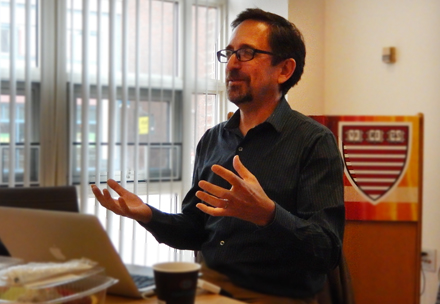Event
Digital Tools Can Help Journalists Cover Complexity of Climate Change, Says Andrew Revkin

April 9, 2014 – Reporting on the issue of climate change has posed many challenges to journalists such as Andrew Revkin, who writes the Dot Earth blog for The New York Times. At the Shorenstein Center on Wednesday, Revkin explained why the complexity of the issue and the limits of news models make for a difficult job, and how digital tools can provide answers.
The public generally responds to clear, simple messages from the media. But climate change is a complicated and evolving issue that can be hard to translate into clear-cut sound bites, Revkin said. He advised journalists covering climate change to keep in mind that people don’t typically respond to vague scientific terminology, but they generally support “energy wisdom” – practical mandates, regulations and limits on emissions.
Traditional news models didn’t always foster an open conversation on complex issues such as climate change, Revkin said. The old model of a handful of news outlets with a definitive world view presenting the news was limited, Revkin said. In comparison, today’s model of digital media, which allows for many voices and opinions, is better.
Revkin admits he is “not a good spokesman for a certain agenda,” but he is “passionate about reality,” and this is his own form of agenda. Op-ed columns aren’t the best way to communicate reality, he said, as people often turn to columnists to reinforce their own preconceived ideas. Instead, journalists should look to social media and non-conventional news outlets as alternative ways of getting the message out. “Journalism is a shrinking wedge of a growing pie of ways to tell stories,” he said. Scientists and journalists need to look for new ways to communicate and share ideas about this important issue.
Article and photo by Janell Sims, Shorenstein Center.